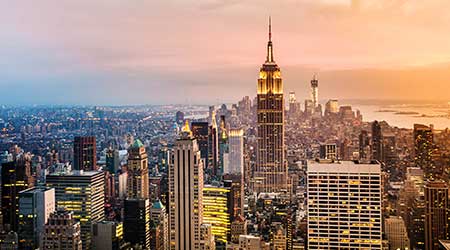In New York City, Tough Rules Target Emissions from Large Buildings
Requirements for solar panels or vegetated roofs already apply to new and replacement roofs.
On April 18, 2019, the New York City Council passed the Climate Mobilization Act, a suite of laws aimed to meet the city’s commitment to achieving carbon neutrality by 2050.
For building owners, the new laws mean new requirements for everything from building emissions to roof materials. Some of the most far-reaching changes go into effect years in the future. But Local Laws 92 and 94 took effect in November 2019 and apply to nearly all buildings.
Local Laws 92 and 94 mandate that roofs on new construction, new roofs resulting from the expansion of existing buildings, and roofs undergoing complete replacement — including the roof deck — be covered with either solar panels or a green (vegetated) roof system. Replacing the entire existing roof deck or roof assembly will trigger compliance with these new laws. Although exceptions are granted for fire code compliance access, small terraces, recreational spaces, and areas housing rooftop equipment, 100 percent of the remaining roof areas are now considered “sustainable roofing zones” and must be equipped with a solar photovoltaic system or a vegetated roof assembly, or both.
Steep-slope roofs are exempt from the green roof requirement, but if they can accommodate at least 4kW of electricity generating capacity, they must have solar panels. Historic buildings subject to Landmarks Preservation Commission regulations are not exempt from Local Laws 92 and 94, but the proposed assembly must first be approved by the Landmarks Preservation Commission before being submitted for permit approval.
For all buildings, roof areas unfavorable to either a vegetated or a photovoltaic assembly, as in cases where the building structure cannot support the added weight, may receive an exemption.
Even for some roof projects that don’t involve full roof assembly or roof deck replacement, the law increases solar reflectance requirements for low-slope roofs and establishes minimum solar reflectance for steep-slope roofs. Certain materials, including glass, metal, clay, and concrete tile, are exempt, as are small roofs and minor setbacks. However, the requirements for solar reflectance are not only more stringent, they apply to many more buildings and roof types than in the past.
For building owners, this means that imminent roof assembly and roof deck replacements, as well as building expansions and new construction projects, need to comply with Local Laws 92 and 94. Solar arrays and green roofs may require structural modifications to accommodate the additional weight, so owners should factor this into their budgeting and timeline.
While both types of assemblies can mean long-term energy cost savings, the up-front expense, as compared with traditional roof systems, can be substantially greater. Owners planning expansions, roof replacements that include the roof deck, or new construction should start preparing now for the new design considerations and address any obstacles to compliance.
In early July 2019, New York City legislators tripled the property tax abatement for green roofs from $5.23 per square foot to $15 per square foot and extended the abatement to 2024 (see New York State Senate Bill S5554B).
Cutting carbon emissions
The centerpiece of the Climate Mobilization Act is Local Law 97 of 2019, which requires certain large buildings in the city to drastically cut carbon emissions to meet successively lower targets, beginning in 2024.
According to the Urban Green Council, buildings larger than 25,000 square feet represent just 2 percent of the city’s building stock yet account for up to half of all building emissions. Because buildings are responsible for nearly 70 percent of overall carbon emissions, driving down emissions from the worst offenders will substantially contribute to meeting the city’s climate goals.
Local Law 97 of 2019, along with the related amendments in Local Law 147, requires buildings of more than 25,000 square feet — or two or more buildings on the same tax lot exceeding 50,000 total square feet — collectively to cut carbon emissions 40 percent overall by 2030 and 80 percent by 2050. For individual buildings, the law identifies specific carbon emissions intensity limits based on building classification and occupancy.
Buildings with rent-regulated units and other types of affordable housing, as well as houses of worship, are exempt from the cap, though they must implement energy-saving measures. Non-profit healthcare facilities can apply for a percent reduction in the emissions limit.
Emissions targets are based on New York City Building Code occupancy groups, with mixed-use facilities having limits that reflect the balance of space use. The law establishes two compliance phases, with an initial period of 2024-2029 and significantly more stringent emissions limits after 2030. The newly established Office of Building Energy and Emissions Performance (OBEEP) at the New York City Department of Buildings is charged with updating and enforcing these requirements.
Carbon offsets, renewable energy credits (RECs), and carbon trading are included in the law as alternate compliance options and may help building owners meet the emissions targets as they work to implement necessary upgrades. Hardship waivers, as well as emissions limit adjustments for buildings facing outsized emissions reductions, are also included in the legislation.
Penalties are steep. Exceeding the emissions cap will cost building owners $268 for each metric ton over the limit, annually. Failure to file a report incurs a fine of 50 cents per building square foot per month, and a report found to be false constitutes a misdemeanor and carries a $500,000 fine.
Local Law 96 establishes a sustainable energy loan program, Property Assessed Clean Energy (PACE), to provide low-interest, fixed-rate loans for renewable energy systems and efficiency retrofits. Tied to a property, rather than to an owner, the repayment obligation is transferrable when a property changes ownership, so those planning to sell a property before energy savings recoup initial costs can still implement upgrades.
Other measures
Besides the green/solar roof mandate, the building emissions cap, and the PACE program, the legislative package also includes Local Law 95, which changes the way energy efficiency grades for buildings are determined. Many more buildings will now be labeled with a grade of D, the lowest, though a few more may now see an A grade under the new distribution.
Also included are Local Law 98, establishing design and maintenance standards for large wind turbines, and Local Law 99, a mandate to evaluate the feasibility of replacing in-city, gas-fired power plants with battery storage systems powered by renewable energy sources.
To improve availability of information on vegetated roofs, Local Law 93 requires the NYC Office of Alternative Energy to post green roof resources on its website.
What should building owners do now?
• Look for energy leaks. Assess the building enclosure to determine where performance improvements can be made. Upgrading heating and air conditioning before making changes to windows, exterior doors, roofs, and other building envelope systems may mean spending more on oversized HVAC equipment that’s not really needed.
• Factor in new green/solar roof requirements. For those planning roof assembly or roof deck replacements, building expansions, or new construction projects, the new roof may need to comply with the mandate on vegetated or solar photovoltaic assemblies. Building owners should check with a design professional to determine what may be required.
• Investigate financing options and incentives. To determine what options are available to cover the cost of mandated upgrades, building owners can begin exploring PACE financing, green roof tax abatements, and other incentives.
• Keep abreast of changes in the law. As the new Office of Building Energy and Emissions Performance is established, new guidelines and clarifications will likely be issued. Building owners should stay in contact with their architect/engineers, energy consultants, and financial and legal advisors to keep tabs on how the evolving Climate Mobilization Act will affect their buildings.
Alison B. Hoffmann (a.hoffmann@hoffarch.com) is communications manager for Hoffmann Architects, Inc.
Related Topics:














